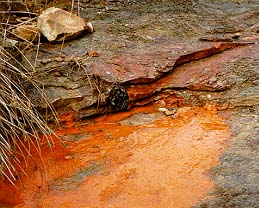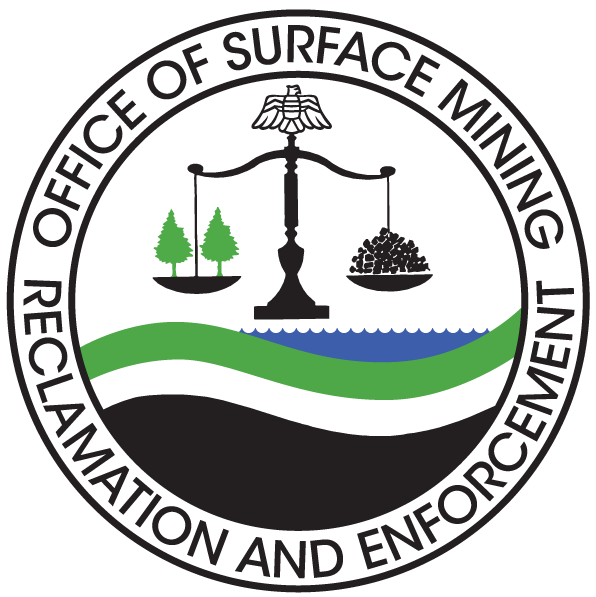Mine Drainage Technology Initiative (MDTI)

The Mine Drainage Technology Initiative (MDTI) - formerly known as the Acid Drainage Technology Initiative (ADTI) - is a forum to address issues associated with mine drainage. This collaborative initiative exchanges information and resources for the purposes of:
- Developing an understanding of acidic and toxic mine drainage (MD) so as to better predict, avoid, monitor, and remediate mine drainage
- Developing innovative solutions to acidic and toxic MD water-quality problems
- Identifying, evaluating, and developing “best science” practices to predict acidic and toxic MD prior to mining
- Identifying successful remediation practices for existing sources of acidic and toxic MD and describe the best technology for its prevention
History of the Mine Drainage Technology Initiative (MDTI)
To combat the long-term water pollution impacts of mining in the coal fields of Appalachia and other areas of coal and metal mining, ADTI was formed as a partnership of technical experts from industry, state and federal agencies, and academia who joined together to combat AMD and related water-quality problems from mining and seek solutions. There are two major units: a Coal Mining Sector (CMS) and a Metal Mining Sector (MMS). Working groups in each sector focused on Prediction and Avoidance /Remediation.
Acid Mine Drainage (AMD)
Acid mine drainage (AMD) is a detrimental by-product of coal mining. At present, acid mine drainage continues to pose a potential problem in some areas, despite improved prediction and prevention techniques. It is a long-term water pollution impact of mining in the coal fields of Appalachia and other areas of coal and metal mining.
AMD or acid rock drainage (ARD), collectively called acid drainage (AD), is acidic water (pH less than 5.0), laden with iron, sulfate and other metals, that forms when geologic strata containing sulfide minerals such as pyrite are exposed to the atmosphere or oxidizing environments.
AMD can form from coal mining, both in surface and in underground mines, but AD can also result from metal mining, or under natural conditions where sulfides in geologic materials are encountered in highway construction, and other deep excavations. Iron sulfides common in coal regions are predominately pyrite and marcasite (FeS2), but other metals may be combined with sulfide in the form of chalcopyrite (CuFeS2), covellite (CuS), and arsenopyrite (FeAsS). Pyrite commonly occurs with other metal sulfides, potential causing AD.
ABA is an important method for predicting post-mining and reclamation water quality and evaluating the potential for production of acid mine drainage. The method, developed in the 1960’s and 1970’s and continuously refined since (Perry, 1998), assesses the potential for the production of acidic drainage at a mine site by balancing the acid-producing and the acid-neutralizing potential of materials at a site to predict the net water quality that can be expected. (Skousen et al., 2002)
The NMLRC has been studying the effectiveness of acid base accounting for predicting post-mining and reclamation water quality (Skousen et al., 2002). Overburden analyses, permit maps, and predictions of post-mining and reclamation water quality data were collected from regulatory agency permit files from several states in the Appalachian coal region. Data collected from these files was used to calculate mass-weighted acid base accounting for each site. Neutralization potential (NP), maximum potential acidity (MPA) and NP/MPA ratio from each ABA were compared to alkalinity levels in post-mining and reclamation water quality data.
The results of the ABA analyses were found to be correct in 82% of the cases using the NP/MPA parameter; this indicates that ABA is a good way to predict post-mining and reclamation water quality at a mine site (Skousen et al., 2002).
OSMRE Headquarters funds studies that meet the purposes (goals) listed above through the ADTI/MDTI program. Annually, OSMRE publishes a notice-of-funding opportunity through grants.gov for a single cooperative agreement with funding up to $200,000 for a period consistent with the proposal but not to exceed two years. We select studies that have the potential for improving the effectiveness of both the coal industry and the regulatory authority to conduct and regulate surface coal mining and reclamation activities that protect the environment and the public.
The following list displays ADTI/MDTI studies that have been awarded and completed since fiscal year 2011:
| Category | Year | Title | Investigator(s) | Institution | Final Report |
|---|---|---|---|---|---|
| ADTI | 2013 | Task 1: Treatment of High TDS Water; Task 2: In-Situ Field-Scale Treatment of Selenium-Bearing Spoil Units; and Task 3: Natural Attenuation of TDS in Mountaintop Mines | Paul Ziemkiewicz | West Virginia University | Task 1: Treatment of High TDS Water; Task 2: In-Situ Field-Scale Treatment of Selenium-Bearing Spoil Units; and Task 3: Natural Attenuation of TDS in Mountaintop Mines |
| ADTI | 2015 | Selenium Diel Cycling and Sorption Kinetics | Dorothy Vesper | West Virginia University | Selenium Diel Cycling and Sorption Kinetics |
| ADTI | 2017 | Temperature-Dependent Selenium Sorption to Mine Drainage Solids: Implications for Diel Cycling | Louis McDonald | West Virginia University | Temperature-Dependent Selenium Sorption to Mine Drainage Solids: Implications for Diel Cycling |
| ADTI | 2018 | Laboratory Investigation of the Effects of Conductivity on a Suite of Stream Organism Found in the Coal Mining Regions of the United States: Amphibians, Benthic Macroinvertebrates and Fish | Mindy Yeager-Armstead Sara Sweeten | Marshall University Virginia Polytechnic Institute and State University | Laboratory Investigation of the Effects of Conductivity on a Suite of Stream Organism Found in the Coal Mining Regions of the United States: Amphibians, Benthic Macroinvertebrates and Fish |
| MDTI | 2021 | Remediation of Coal Mine Drainage with Industrial Byproducts | Kaoru Ikuma | Iowa State University | Remediation of Coal Mine Drainage with Industrial Byproducts |
| MDTI | 2022 | Quantifying the geochemical evolution of water discharged from a flooded mine pool to optimize mine drainage treatment strategies | Rosemary C. Capo
Brian W. Stewart
Charles A. Cravotta III
Dorothy J. Vesper | University of Pittsburgh University of Pittsburgh U.S. Geological Survey U.S. Geological Survey | Quantifying the geochemical evolution of water discharged from a flooded mine pool to optimize mine drainage treatment strategies |
For More Information
Contact Kristin Brown via email (kbrown2@osmre.gov).

